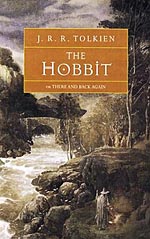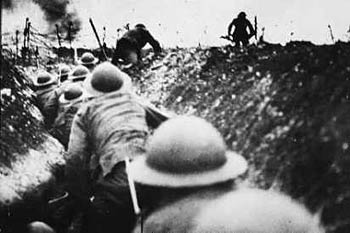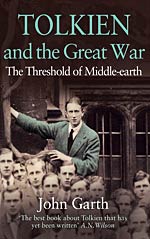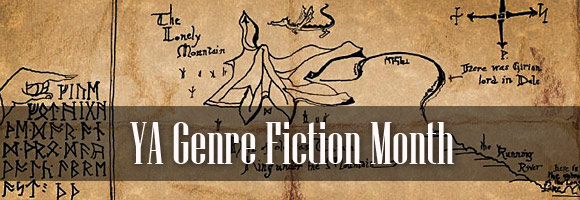YA Genre Fiction Month: Bilbo the Doughboy
 When you think of WWI fantasy, especially in the young adult genre, you might think of steampunk sci-fi, like Scott Westerfeld‘s Leviathan series. I, on the other hand, think of The Hobbit. Tolkien wrote this classic in 1937, well after the Great War, but much of it came from his experience in the trenches. The book begins with Bilbo puttering around Bag End in the idyllic setting of the Shire, not unlike Tolkien’s own neighborhood in north Oxford. He is then, quite literally drafted by Gandalf to join a platoon of dwarves and sent to the front of a war to witness the Desolation of Smaug. It’s a story similar to Tolkien’s own experience in the Great War, where he was struck with trench fever in 1916. It was while recovering from the disease that he began writing The Book of Lost Tales, which would establish the history and continuity of Middle-Earth.
When you think of WWI fantasy, especially in the young adult genre, you might think of steampunk sci-fi, like Scott Westerfeld‘s Leviathan series. I, on the other hand, think of The Hobbit. Tolkien wrote this classic in 1937, well after the Great War, but much of it came from his experience in the trenches. The book begins with Bilbo puttering around Bag End in the idyllic setting of the Shire, not unlike Tolkien’s own neighborhood in north Oxford. He is then, quite literally drafted by Gandalf to join a platoon of dwarves and sent to the front of a war to witness the Desolation of Smaug. It’s a story similar to Tolkien’s own experience in the Great War, where he was struck with trench fever in 1916. It was while recovering from the disease that he began writing The Book of Lost Tales, which would establish the history and continuity of Middle-Earth.
 At first glance, trench warfare might not seem like a suitable inspiration for a children’s book. Perhaps that is why it took so long for The Hobbit to be written. Although set in Middle-Earth, Bilbo’s story wasn’t penned until the 1930s, when, upon spying a blank sheet of paper Tolkien impishly wrote "In a hole in the ground, there lived a hobbit." It might have been terror and illness that inspired Middle-Earth for the author, but the first published account of that world would be more childlike and innocent.
At first glance, trench warfare might not seem like a suitable inspiration for a children’s book. Perhaps that is why it took so long for The Hobbit to be written. Although set in Middle-Earth, Bilbo’s story wasn’t penned until the 1930s, when, upon spying a blank sheet of paper Tolkien impishly wrote "In a hole in the ground, there lived a hobbit." It might have been terror and illness that inspired Middle-Earth for the author, but the first published account of that world would be more childlike and innocent.
In this sense, one might say that the story of Tolkien’s world is backwards. The Book of Lost Tales was the first thing Tolkien put to paper, but it wouldn’t be published until 1992, long after the author’s death. We, the reader, would begin not in desolation, but in delight. That’s how it started for me, of course. The Hobbit was one of the first YA books I ever read (after The Chronicles of Narnia by C.S. Lewis, and Ursula K. Le Guin‘s Earthsea Trilogy). It was a great transition for me, because it was really the only YA book set in Middle-Earth. Of course, I read the entire Lord of the Rings series as a teenager, but it was really intended for adults. By the time I graduated to The Silmarillion, I was out of my element. At 14, I barely understood the mature themes and deep mythological references.
 The Hobbit, then, is not just a children’s or a YA book. It’s an introduction to wider world that continues to expand in depth and complexity as its reader matures. It is, as the best of fantasy ought to be, the first in a series of books that taps into human tradition and reminds us of what we once believed…and might believe again. What does all of that have to do with a fruitless war that is universally regarded as a dark chapter in human history? Like many works of the Lost Generation, it is a reaction to the event — one that recognizes the inevitability of conflict and human misery. Unlike many of those works, however, there is more hope than mourning. Bilbo returns from his war changed, possibly less innocent, but not truly lost.
The Hobbit, then, is not just a children’s or a YA book. It’s an introduction to wider world that continues to expand in depth and complexity as its reader matures. It is, as the best of fantasy ought to be, the first in a series of books that taps into human tradition and reminds us of what we once believed…and might believe again. What does all of that have to do with a fruitless war that is universally regarded as a dark chapter in human history? Like many works of the Lost Generation, it is a reaction to the event — one that recognizes the inevitability of conflict and human misery. Unlike many of those works, however, there is more hope than mourning. Bilbo returns from his war changed, possibly less innocent, but not truly lost.
There is a reason an entire genre was inspired (perhaps overly so) by this new kind of young adult fantasy, and, as great as our current crop of writers are, I’m not entirely convinced that they have topped this classic.



















 Full Details
Full Details



7 Comments
Thanks for this review of The Hobbit. I tried to read Lord of the Rings in junior high, got bogged down, and never liked it. You succeed in making The Hobbit sound interesting. I never knew to place it is the context of WWI, let alone consider it part of the Lost Generation group of novels,Good job.
I read The Hobbit when I was 15. A teacher back then gave me her copy to read. I have read it a few times since, and these notes have me now eager to read it yet again – perhaps over the festive season. I also never saw the WWI connection. Thanks for that. It places the book in ever better context as precursor to the much darker The Lord of the Rings. I must get Garth’s work on this. I do love this sentence in your notes: "Unlike many of those works, however, there is more hope than mourning. Bilbo returns from his war changed, possibly less innocent, but not truly lost."
> "…but much of it came from his experience in the trenches. "You haven’t really sold, or given evidence that idea in this post.Obviously Tolkien was influenced by his experiences, like everyone is. But the comparison of the Hobbit to WW1 seems even weaker than the more popular, but still IMHO dubious comparison of LotR to WW2. Does this really help you understand what he wrote? Does it give you insight in to characters and events? Or is this theory just psychoanalyzing the author?It seems to me a better explanation of the Hobbit is that Tolkien (as he has stated) was writing a story for children, but that lots of the stuff he was interested in (Medieval history, Mythology, his own proto-Simarilion mythology, got sucked into it.> "I’m not entirely convinced that they have topped this classic."On that we agree. 🙂 I’ve read it many times since i discovered it as a young teen.> "In a hold in the ground, there lived a hobbit."I presumed that’s supposed to be "hole".
Gah! your comment function ate all my nice line breaks. The above is much less readable than what i intended.
jwbjerk: We’re working on the formatting issues. They should be fixed in the coming months! There are a lot more parallels to WWI than is in my post. My intention wasn’t so much to "prove" the link as to refer to it. I mentioned the drafting of Bilbo (an experience every doughboy would recognize), the contrast between the Shire and the Desolation of Smaug (nothing would grow in the Desolation, just as nothing grew in the trenches), and the obvious hell that was war. Another element that I might have mentioned was the long march forward toward certain doom. For Tolkien, nature was everything and the loss of it was horrific. Being a member of the Lost Generation, he would have experienced this first hand at the front. Finally, I mentioned the fact that the Middle Earth was invented during his recovery from Trench Fever. Had I been trying to prove the link, I’d simply have quoted Tolkien himself, who said in the preface to the second edition of the LotR that parallels with WWII were mistaken that that WWI had taken from him all of but one of his friends. I do agree that the Hobbit was intended for children, but do remember that it was written 20 years after the beginning of the Lost Tales, which was decidedly more adult.
Charles and Emil: Do let us know if you reread the Hobbit. I’m very interested in how people think it holds up in adulthood.
I’m actually in the process of re-reading the Hobbit. From my adult perspective, I would say that it starts off feeling a bit stilted, but then quickly becomes just as wonderful as I remember from my childhood. It’s almost more interesting to read as an adult, since I’ve been exposed to so much more speculative fiction in the meantime. My familiarity with modern fantasy makes it abundantly clear just how dramatically Tolkien’s work shaped, and continues to shape, the genre it inspired.
Sorry, the comment form is closed at this time.